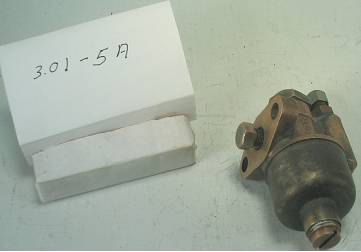Refrigerant Flow Controls – Household
An early, compact, spring compensated, adjustable, automatic expansion valve for use on “dry evaporators”, apparently manufactured for Kelvinator by the M B Company, with heavy cast brass body, flange mounted and equipped with bronze bellows, screw adjustment shaft seal, engineered for sulphur dioxide refrigerant, Kelvinator Model C1, circa 1932. One of a set of two identical valves, see Ref code 3.01-5B, ID # 173.
Technical Significance:
An example of the new generation of compact, more precisely engineered and performing expansion valves emerging early in the 1930’s, used to maintain cooling units [evaporators], in mechanically cooled refrigerators, at the desired refrigerant pressure.
Dramatises the major gains made by the industry over a period of less than 5 years, during a period of feverish research and development using the scant knowledge and experience available to workers in the field at the time, compare ID # 165 to 168
This artifact of history tells the many stories of early adoption of this particular fluid flow technology, the automatic expansion valve. After a brief flurry of excitement over the use of more costly and delicate float operated devices, as a more efficient means of flow control, industry engineers would return to the automatic expansion valve in the early 30’s. But by then the automatic expansion valve would be a smaller and much more precisely calibrated and efficient device. While the automatic expansion valve was less efficient in its effective use of evaporator surface than high and low side float systems [See HHCC Series 3.01 artifacts, ID # 175 and 176 for example], it had the advantage of reliability, maintainability and affordability, as well as serviceability.
Industrial Significance:
It was a period of rapid industry growth, as well as technological development and innovation in the refrigeration industry. Systems were becoming increasingly complex as the industry moved to improve their reliability and performance. Small satellite manufacturers, characterized here by the M B Company, were attracted to the rapidly evolving field in the hopes of securing contracts for the production of component parts. The phenomena of industrial out-souring had been discovered by Kelvinator.
The fact that the M B Company seems to have been relatively short lived tells many of the stories of the times – companies without the resources for sustainability in a rapidly evolving field.
The engineering sophistication and advancements in manufacturing, assembly and materials utilization, represented here, in contrast to ID # 165-168 stands as a remarkable industry achievement.


